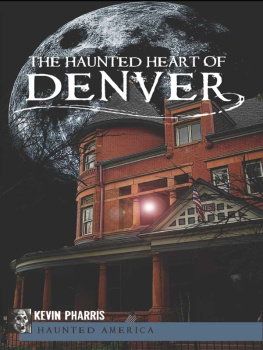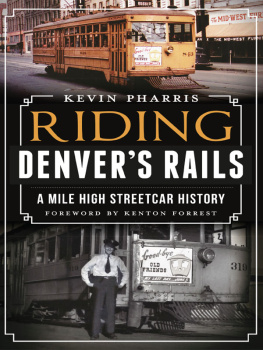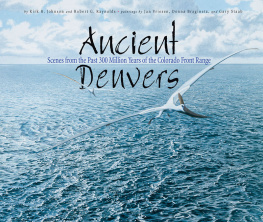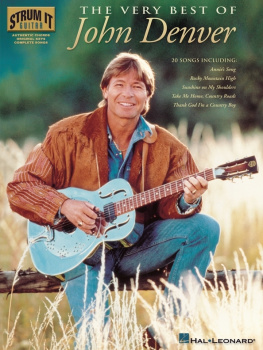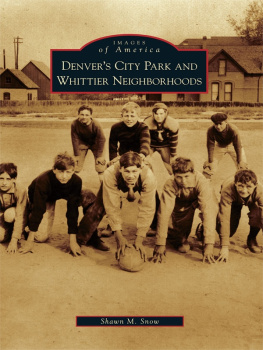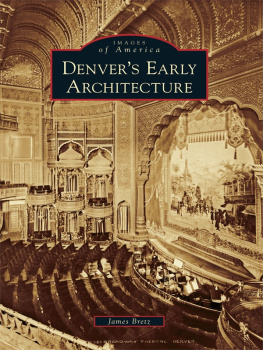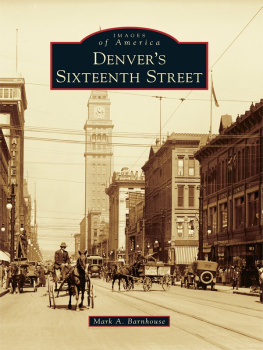COLORADO HISTORY
16
DENVERInside & Out

Denver 2011
Colorado History
ISSN 1091-7438
Number 16
2011

Research and Publications Office
Managing Editor
Steve Grinstead
State Historian
William J. Convery III
Editor
Ben Fogelberg
Assistant Editor
Liz Simmons
Graphic Designer
Susan Romansky
EDITORIAL REVIEW BOARD
Vincent C. de Baca
Maxine Benson
William Gwaltney
David Fridtjof Halaas
Stephen J. Leonard
Patricia Nelson Limerick
Thomas J. Noel
Duane A. Smith
Volume Editor
Larry Borowsky
Cover: The iconic Daniels & Fisher TowerDenvers original high-risedominates a
downtown scene. 10024306
History Colorado publishes Colorado History to provide a flexible scholarly forum for well-written, documented manuscripts on the history of Colorado and the Rocky Mountain West. Its structure is designed to accommodate article-length manuscripts in the traditional journal style and longer, book-length works which appear as monographs within the series. The publications of History Colorado generally follow the principles and conventions of the Chicago Manual of Style, and an authors guide is available on request. Manuscripts and letters should be addressed to: Publications Office, History Colorado, 1560 Broadway, Suite 400, Denver, CO 80202. History Colorado disclaims responsibility for statements of fact or opinion made by contributors.
All illustrations are from the collections of the History Colorado unless otherwise indicated.
2011 by History Colorado, the Colorado Historical Society
All rights reserved
Printed in the United States of America
Forward!
Denver, Colorado, turned 150 in 2008not too shabby for a city so down on its luck in 1868 that Cheyenne boosters deemed it too dead to bury. Europeans, of course, can point to Paris, London, or Rome to show American upstarts how recent their antecedents go. And in the United States, 2008 saw the 400th anniversary of Jamestown, the 399th of Santa Fe, and the 378th of Boston. Even Los Angeles, a city of seemingly eternal youth, dates back more than seventy-five years before Denvers first town meeting.
Denvers advantage over these older cities, though, is that most of its history is a recent memory. The citys entire story spans two human lifetimes, which means that our parents and grandparents knew people who were here at the beginning. Denvers youth also gave Denverites a chance to celebrate how fast weve come up in the worldfrom a log-and-canvas village of a couple hundred in 1858 to a mile-high metropolis of more than 600,000 (and more than 2.5 million in the metropolitan area) today.
Denvers rise into a regional economic and political center and self-proclaimed Queen City of the Mountains and Plains helped shape, and in turn was shaped by, our regions politics and economics, culture and societysometimes to the benefit of all, sometimes at a great cost to neighboring communities. Along the way, the city survived floods and drought, fires and epidemics, booms and busts, race and labor riots, the slings and arrows of regional rivals, and the Denver Broncos vertically striped socks.
In 2009, scholars from around the world traveled to Denver to acknowledge the Mile High Citys rapid ascent. As part of its sesquicentennial exhibit, Denver: Imagine a Great City, History Colorado invited scholars to give panels and papers for its Denver Inside and Out symposium. The symposium presented new research that framed the qualities and circumstances that helped the city rise far above its humble roots, and illustrated the ways Denver residents have never stopped imagining a great city.
Scholars and attendees considered Denvers influence on the development of local and regional land and water use policies, transportation and recreation, legal and economic issues, politics, society, music, literature, culture, sports, and leisure. And while the scholars works looked back at Denvers last 150 years, they also nodded toward the future. So, the edition of Colorado History that you hold in your hands features a selection of those essays, gathered as Coloradans seek the historical context that can help frame their discussions about Denvers next 150 years.
The essays illustrate how pioneers build enduring educational, medical, and transportation systems, how Denvers social and political climate contributed to the elevation of women, how Denver residents wrestled withand exploitedthe citys natural features, and how diverse cultural groups became an essential part of the citys fabric. Published just a year out from the opening of the new History Colorado Center, this journal also hints at some of the social, economic, legal, and environmental issues that Denverites now have before them.
In that sense, it speaks to History Colorados charge to cultivate an understanding of our shared past in order to help us all make better decisions about our common present and future.
William J. Convery, STATE HISTORIAN
COLORADO HISTORY
Building
Denver
Rails to the Rockies
How Denver Got Two Railroads (Sort of),
but Not the One It Really Wanted
Eric L. Clements
Above: Laying the track for the Kansas Pacific Railroad. From New Tracks in North America by William A. Bell (London: Chapman and Hall, 1869).10027376
To understand Denvers enthusiasm for railroads, consider the alternatives. The towns first stagecoach arrived in May 1859 after a nineteen-day slog from Leavenworth, Kansas. Service got faster, a week to ten days, but never much easier. Demas Barnes, traveling west from Atchison, Kansas, described the stagecoach experience as fifteen inches of seat, with a fat man on one side, a poor widow on the other, a baby in your lap, a bandbox over your head, and three or four more persons immediately in front leaning against your knees. Even the arrival of the railhead at Cheyenne in 1867 only alleviated the stage trips agony by decreasing its duration.
And such abuse did not come cheap. In the spring of 1859, John M. Hockaday & Co. advertised stage service from Atchison to Denver City for $100 per passenger and board, with forty pounds of baggage. If you intended to do more than visit, you would need much more than forty pounds of kit. Pratt and Hunts 1859 Guide to the Gold Mines of Kansas recommended that a party of four outfit themselves with 3,000 pounds of supplies for a six-month sojourn at the mines. To haul this household, the guide suggested using oxen at $80 to $100 per yoke or mules for $125. Mules could make the passage from eastern Kansas to the mines in thirty days, oxen in thirty-five or so. The guide put the cost of moving freight by freight express trains over the same distance at $250 a ton. That first season one company advertised an ox-team express for $50, with a transit of about 30 days. One small detail: Women, children or sick persons only will be allowed to ride by this express. To those accustomed to walking... this will be a pleasant and cheap mode of conveyance.



